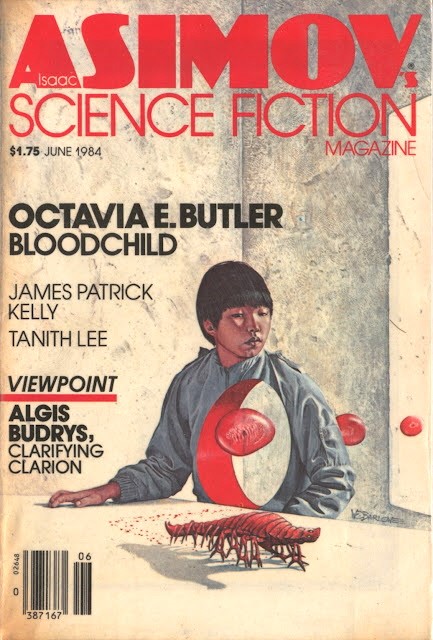
Title: Bloodchild
Author: Octavia Butler
Date of First Publication: June 1984
Place of First Publication: Isaac Asimov’s Science Fiction Magazine (New York, NY: Davis Publications)
Bibliographic Reference: isfdb
Type: Short Story
Keywords: ANDROID; SYMPATHETIC MONSTER; RACE and POLITICS; POSTHUMAN; WOMEN WRITING MONSTERS
Critical Summary: In the future, an insect-like alien race called the Tlic has set up a Preserve on their planet to keep human beings, called Terrans, for reproductive purposes. Female Tlic cannot bear their own children, so they use Terran males as living incubators, implanting eggs when the time is right and harvesting the young from inside the abdomens of the males after a time. The Tlic create familial-type bonds with the host of their choosing using a sort of analgesic produced by a stinger, and supply their Terran hosts with unfertilized eggs which have a strengthening power. Although the Tlic maintain an honored position in society and within the host’s family, a distinct tension between the Tlic and the Terrans remains. In this story, this tension is displayed primarily through the relationship between the Tlic T’Gatoi and the Terran Lien, whose son Gan is slated to carry T’Gatoi’s offspring.
One night, T’Gatoi and Gan’s family discover a man named Bram Lomas who has found his way to Gan’s family home. Carrying Tlic offspring inside him (referred to as being N’Tlic) but unaccompanied by the female Tlic that impregnated him, Lomas begins experiencing a painful and distressing “birth” process. Gan’s brother Qui goes out to retrieve Lomas’s Tlic. T’Gatoi assumes the role of Lomas’s Tlic, requesting that Gan go out to kill and bring her an animal called an achti that will act as a first meal for the newborn grub. T’Gatoi then gets to work, first knocking Lomas unconscious with a sting, then cutting his abdomen open and removing the larval Tlic one at a time. She then closes Lomas up and his Tlic arrives with Qui, surging into the house while Gan goes outside and, overcome with disgust and horror, vomits.
Qui, who has a strong negative bias toward Tlic, describes a horrific event he witnessed to Gan, in which a Tlic refused to remove her offspring from her host because there were no animals around that the young could eat. The man, desperate from relief from his pain, begged the Tlic to kill him and eventually she did, allowing the grub to eat him. Qui reveals that it was this event that illuminated the cruel and painful process that birthing Tlic is in reality, rather than the sugar-coated version the Terrans had been told their whole lives. Because of Qui’s refusal to carry T’Gatoi’s offspring, the duty fell to Gan. However, after witnessing the pain Lomas experienced during the birthing process and the brutality by which it was carried out, Gan reconsiders his own position as host and toys with the idea of passing the duty on to his sister, Xuan Hoa. After his conversation with Qui, though, Gan reflects on his father—who carried Tlic offspring multiple times—and decides to follow through with his duty and save his sister from the process. The story ends with T’Gatoi impregnating Gan in a gender-reversed sexual act, promising that she will take care of Gan and never leave him alone.
The primary connection between “Bloodchild” and Frankenstein is in the two stories’ treatment of humanity and othering. In “Bloodchild,” humans are stripped of some freedoms to serve the Tlic. In fact, their humanity is reduced to a single function, and even in this one function they are completely passive. They rely on the Tlic to impregnate them and again to deliver the offspring. In much the same way, Frankenstein revolves around the de-humanizing experiences of the creature. The emphasis Victor places on the creature is purely scientific, and in this, the creature is reduced to simple functions that indicate his “aliveness”—a heartbeat, breathing, etc. Additionally, though one involves males giving birth and the other a scientist reanimating dead tissue, both stories involve a fear of creation or “motherhood.” Though the Tlic are monstrous and cold-hearted, they are also invested in keeping their host alive and well, living with them and nurturing a relationship with their host’s family. Thus, because their intentions are not wholly bad, the Tlic become in some ways sympathetic. Because the Tlic are only interested in keeping the female of their species alive and using human males for reproductive purposes, the story also becomes gender-oriented.
Administrative Notes: Molly Robertson, CSUF

